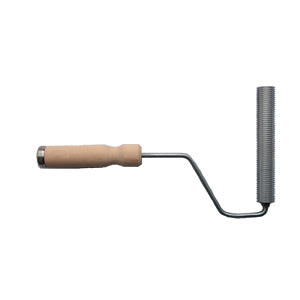You have no items in your shopping cart.
It is important to use a roller or squeegee when working with fiberglass and resin. They are used to evenly saturate the fabric, help get rid of air pockets and also get rid of the excess resin in the fabric. If you have too much resin, spots without resin or bubbles in your finished product, you run the risk of it being weak and breaking. Using a good roller will help in creating a strong finished product.
There are several different roller options.

Deluxe aluminum rollers have grooves (fins) and have a wood handle. The roller has grooves (fins) to help distribute resin and get rid of air trapped within the fabric weave. The wood handles make for a sturdy roller. Aluminum rollers are recommended when increased pressure is needed particularly on large applications.
Economy rollers are also aluminum finned but have plastic handles. They are much cheaper than the wood handled rollers. Plastic laminating rollers are also available. Deluxe, economy and plastic laminating rollers are all ideal for flat surfaces.

Corner (also known as filet) rollers are designed for concave surfaces and filets where flat rollers are not effective. They eliminate bubbles in critical inside corners. Corner rollers are machined with the deepest fins possible for an efficient air relief and excellent lay up properties. They save time when rolling out non-flat surfaces.

Barrel rollers are also designed for curved and concave surfaces where flat rollers are not effective. They are wider in the middle and smaller on the ends. Radius/barrel rollers are perfect for small areas. They have deep fins.

Bristle rollers are used when conventional finned rollers are not efficient at removing the air in a particular laminate. Bristle rollers work well with knitted / uni-directional fibers to remove air pockets. They also work well in skin coats and mold construction.
All of these rollers are typically sold with the option for both plastic and wood handles. Many have interchangeable roller heads.
For more information on other accessories that can be used with working with fiberglass and resin, check out our Ultimate Fiberglass and Resin Guidebook for Beginners.
comments (5)
-

-
 Brent
BrentI would like to know more about the bristle roller and how that one works.
-
 Fiberglass Warehouse
Fiberglass Warehouse@Vince V. – Dip them in acetone to clean them up.
-
 Vince V.
Vince V.what is the best way to clean aluminum rollers when used with either polyester or epoxy resin?
-
 Gary Bobzin
Gary BobzinHi I am about to start my first glass covered model it is a 100″ Spitfire and is ready for glassing and I know nothing about this process so would like any onfo on what I should buy
REPLY from fgwarehouse: I would check out RC forums to get the best answer. 3/4 oz and 1.5 oz are the most common RC fiberglass cloth used, but since your plane is bigger than the typical RC plane, you may need to go with a 3.2 oz cloth. As far as resin, I would use the 4:1 epoxy resin. It will do the best.










Brent- You can see our latest user guide for the fiberglass rollers. https://fiberglasswarehouse.com/blogs/news/fiberglass-rollers-user-guide I hope you find it helpful in answering any questions you have. If you still have questions, please send them to salesfiberglasswarehouse.com